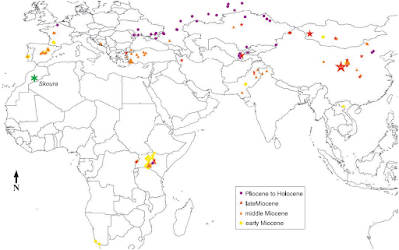Today only five species of Rhinoceros survive, all of which are highly endangered, but the fossil record contains about fifty genera of these Animals, which, even allowing for some exaggeration due to descriptions based upon fragmentary specimens, makes them among the most successful large Mammals of the Neogene. Rhinoceroses can be divided into two distince evolutionary lineages, the Rhinocerotinae and the Elasmotheriinae, although Early and Middle Miocene forms can be hard to assign to either group with confidence, by the Late Miocene the two Rhinoceros types had diverged enough to make differentiation fairly simple.
In a paper published in the journal Acta Palaeontologica Polonica on 19 October 2021, Denis Geraads of the Centre de Recherche en Paléontologie du Paris at the Sorbonne Université and the Muséum National d’Histoire Naturelle, and Samir Zouhri of the Department of Geology at the Hassan II University of Casablanca, describe a new species of Elasmotheriine Rhinoceros from the Late Miocene deposits northeast of Skoura in the Ouarzazate Basin of Morocco.
Miocene Mammals are collected by commercial fossil hunters to the north of a section of road between Skoura and Tizi N’Tadderht, roughly 50 km to the northeast of Ouarzazate. Two genera of Rhinocerotine Rhinoceroses have been tentatively identified from these deposits, based upon teeth, a partial mandible, and some post cranial remains, as well as remains ascribed to Elephants, Goats, Ostriches, Turtles, Crocodiles, Horses, Pigs, and Giraffes. Late Miocene Mammal faunas are rare in Africa, which makes the dating of deposits by Mammal remains difficult, thus the exact age of these fossils is unclear, and it is likely that they are not all completely contemporaneous, although they probably do not encompass a very great time-span. However, Geraads and Zouhri favour an early Late Miocene age for the fossil-bearing strata.
The new species is described on the basis of material purchased from a fossil hunter by Serge Xerri in Rabat, and donated by him to the Aïn Chock Faculty of Sciences at Hassan II University of Casablanca. It is named Eoazara xerrii, where 'Eoazara' derives from 'Eo' the Greek for 'dawn' and 'azara' the Amazigh (Berber) for 'Rhinoceros', and 'xerrii' honours Serge Xerri. The material upon which the description is based comprises a skull with the associated mandible, a partial humerus, a lunar, and a trapezoid.
Eoazara xerrii was a large Animal, similar in size to the largest living Rhinos, albeit somewhat more slender. The skull is relatively well preserved, lacking most of the occiput, but retaining the right occipital condyle and basicranium. Most of the right mandible is preserved, as is part of the left; these are attached to the cranium and cannot be separated. The skull is slightly crushed dorsoventrally, but not so much as to greatly alter its proportions. The right mandible is in life position at the articulation with the skull, but shifted by about 30 mm at the anterior, with the lower second premolar being in front of the upper. The teeth of the lower right mandible are preserved, but hard to access, the upper jaw retaining only the second and third molars, which are heavily worn.
The skull is longer than it is broad, with long fused nasal bones which are inflated and terminate in a tip that points towards the premaxillae. A large rugose patch on the dorsal surface of these nasals ndicated the former presence of a single horn. It is possible that there was also a smaller frontal horn, but there is no evidence for this. The premaxillae are long and slender, and lack teeth.
The postcranial material was derived from the same block as the skull, and the absence of any duplicate parts combined with a similar size is taken to indicate that these came from the same Animal.
Elasmotheriine Rhinos were widespread in Eurasia in the Miocene, but much less common in Africa, with most of those that have been recorded coming from East or Southern Africa. In North Africa only a few teeth from a probable juvenile Elasmotheriine are known.
Curiously, a phylogenetic analysis carried out by Geraads and Zouhri did not find that Eoazara xerrii was closely related to other African species of Elasmotheriines, nor even European ones, but rather with Asian species, with its closest relatives being Iranian, Chinese, and Siberian species. This suggests a distribution along the southern shores of the Tethys Ocean in the early Late Miocene, with European and other African forms arriving in their locations via separate routes out of Asia.
The teeth of Eoazara xerrii are not well preserved, but it appears to have had a high cement cover with complex shapes on its occlusal surfaces (i.e. those surfaces which grind against one-another during chewing), which are generally taken as adaptations to grazing on Grasses. This fits well with the other Mammals found at Skoura, which are likely to have inhabbited an open, savanah-like biome. Such Savanah ecosystems are know to have appeared in the Late Miocene in the area between Iran and the Balkans, as well as in Morocco, whereas it is not thought to have reached Iberia until some time later. The presence of an Elasmotheriine Rhinoceros species in Morocco, adapted to this environment and closely related to Asian forms, strongly implies that by this time Savanahs had spread along much of the coast of North Africa.
See also...



Online courses in Palaeontology.
Follow Sciency Thoughts on Facebook.
Follow Sciency Thoughts on Twitter.







